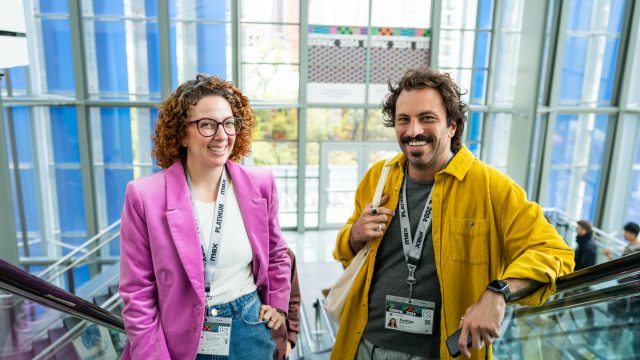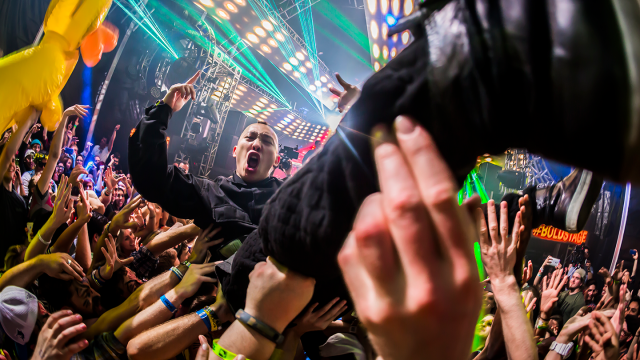There is a house in Santa Fe, New Mexico. The family that lived in it has vanished, having disappeared into the tangle of corridors and rooms that spill out across space and time. If you wander through those 70 rooms, you will encounter bizarre forests, banks of televisions, and enormous caterpillars. The mystery of what happened to that family is up to you as a visitor to solve.
“The House of Eternal Return,” which opened in 2016, is the first major interactive art installation developed by Meow Wolf, a Santa Fe-based art and entertainment company with a growing portfolio. The house, located in Meow Wolf’s headquarters in a converted bowling alley, is an example of a growing trend of interactive and experimental art spaces that seek to draw visitors into larger narrative experiences.
“People really like explorable storytelling experiences,” explains Joanna Garner, Senior Narrative Director at Meow Wolf. “When you mix a mind-blowing visual experience with immersive and nonlinear storytelling, you get something really special.”
Meow Wolf’s installations are designed to gently draw people into a broader narrative, and to give them a seamless, interactive experience in navigating it. According to Garner, they focus on the “accessible unknown,” using initially familiar settings, such as a house, as a bridge to strange and magical locations. Creating a nonlinear narrative involves tinkering with how to signal important details in a subtle way — leaving a binder of information out with bookmarks to important passages, or adding light so that particular clues are visible. “We think about it in terms of signposts, trailheads, and payoffs,” Garner says. A trailhead establishes a narrative thread; signposts suggest how to follow it; and the payoffs offer the reward.
“When you mix a mind-blowing visual experience with immersive and nonlinear storytelling, you get something really special.”
This might sound similar to escape rooms, which also focus on environmental storytelling (albeit in a puzzle-solving context). But Garner, who was initially trained as a playwright at the University of Texas at Austin, notes that Meow Wolf’s presentation is closer in some ways to immersive theater.
This makes sense because interactive and site-specific theatrical events have a long history of attempting to bring the audience inside the narrative. Sleep No More, an interpretation of Macbeth by the company Punchdrunk that opened in New York City in 2011, is a famous recent example. The audience can interact directly with the performers, not only piecing the story together but actually joining it. That live theatrical component is an artistic direction that Garner is interested in pursuing: “You get that amazing thing that happens when you’re in a space, and you’re seen by the space and by the performer, and you’re in this beautiful communal co-creation.”
Sound is also a major factor in creating an immersive experience, says Meow Wolf sound designer Meason Wiley. You don’t want the soundscape to be tied to speakers, or feature obvious loops. “A lot of times we’re using a lot of very unique spaces not necessarily designed for sound,” Wiley said.
He says that his team has been working to incorporate autonomous audio systems that gather data about the space and modify themselves through machine-learning to create unique and organic soundscapes. They also use robotics to create physical noises, such as massive armatures that clang together to create industrial sounds. Wiley says that since the same computer systems control the lights, physical motors, and simulated sounds, the space can react holistically to the data it takes in.
These sorts of integrations of visual and sound are becoming fertile testing grounds for all kinds of artistic installations, from the commercial — Disney World’s new Star Wars: Galaxy’s Edge park, which tries to fully immerse visitors in a distant galaxy — to immersive museum exhibits, such as in New York City’s Tenement Museum — to the more broadly experimental. All of these different approaches ultimately seek the same thing — to drop visitors into a world of the artist’s choosing, as surely as if they’d fallen through a real portal at “The House of Eternal Return.”
“As world-builders we have a responsibility to imagine a world we want to live in,” Garner emphasizes. “Because we’re living in an age when things feel bleak, there’s a tendency for world-building in video games or large epic franchises to tend toward a really dystopian view, or a strong look at good versus evil, or pure escapism ... I’m interested in how we create immersive experiences that encourage people to step inside and participate in the world versus passively watching it ... The ultimate reason for being alive is to create and manifest.”
Learn more at SXSW 2020 in the Experiential Storytelling Track, and check out the immersive installations in the SXSW Art Program.



